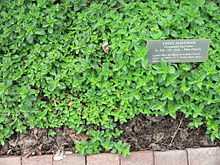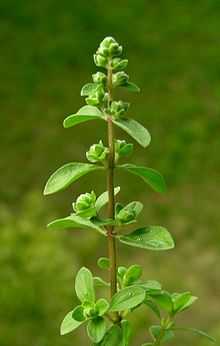Marjoram
| Marjoram | |
|---|---|
 | |
| Scientific classification | |
| Kingdom: | Plantae |
| (unranked): | Angiosperms |
| (unranked): | Eudicots |
| (unranked): | Asterids |
| Order: | Lamiales |
| Family: | Lamiaceae |
| Genus: | Origanum |
| Species: | O. majorana |
| Binomial name | |
| Origanum majorana L.[1] | |


Marjoram (Origanum majorana, syn. Majorana hortensis Moench, Majorana majorana (L.) H. Karst[2]) is a somewhat cold-sensitive perennial herb or undershrub with sweet pine and citrus flavors. In some Middle-Eastern countries, marjoram is synonymous with oregano, and there the names sweet marjoram and knotted marjoram are used to distinguish it from other plants of the genus Origanum.
The name marjoram (Old French majorane, Medieval Latin majorana) does not directly derive from the Latin word maior (major).[3] Marjoram is indigenous to Cyprus and southern Turkey, and was known to the Greeks and Romans as a symbol of happiness.
Cultivation

Considered a tender perennial (USDA Zones 7-9), [4] marjoram can sometimes prove hardy even in zone 5.
Marjoram is cultivated for its aromatic leaves, either green or dry, for culinary purposes; the tops are cut as the plants begin to flower and are dried slowly in the shade. It is often used in herb combinations such as herbes de Provence and za'atar. The flowering leaves and tops of marjoram are steam-distilled to produce an essential oil that is yellowish in color (darkening to brown as it ages). It has many chemical components, some of which are borneol, camphor and pinene.
Related species
Oregano (Origanum vulgare, sometimes listed with marjoram as Origanum majorana) is also called wild marjoram. It is a perennial common in southern Europe in dry copses and on hedge-banks, with many stout stems 30–80 cm high, bearing short-stalked, somewhat ovate leaves and clusters of purple flowers. It has a stronger flavor than marjoram.
Pot marjoram or Cretan oregano (Origanum onites) has similar uses to marjoram.
Hardy marjoram or French marjoram, a cross of marjoram with oregano, is much more resistant to cold, but is slightly less sweet. Origanum pulchellum is known as showy marjoram or showy oregano.
Uses
Marjoram is used for seasoning soups, stews, dressings and sauce. [5] Majorana hortensis herb has been used in the traditional Austrian medicine for treatment of disorders of the gastrointestinal tract and infections.[6] In Germany, marjoram is known as "Goose Herb" (Gänsekraut) for its traditional use in seasoning roast goose; the goose is roasted with dried marjoram in the body cavity.
References
- ↑ "Origanum majorana information from NPGS/GRIN". ars-grin.gov. Retrieved 2008-03-08.
- ↑ "Germplasm Resources Information Network (GRIN)". Retrieved 2011-11-23.
- ↑ Marjoram, Online Etymology Dictionary, Douglas Harper, November 2001
- ↑ Learn 2 Grow: Origanum majorana
- ↑ M. G. Kains (1912). American Agriculturist, ed. Culinary Herbs: Their Cultivation Harvesting Curing and Uses (English). ORANGE JUDD COMPANY.
- ↑ Vogl S, Picker P, Mihaly-Bison J, Fakhrudin N, Atanasov AG, Heiss EH, Wawrosch C, Reznicek G, Dirsch VM, Saukel J, Kopp B. Ethnopharmacological in vitro studies on Austria's folk medicine - An unexplored lore in vitro anti-inflammatory activities of 71 Austrian traditional herbal drugs. J Ethnopharmacol.2013 Jun13. doi:pii: S0378-8741(13)00410-8. 10.1016/j.jep.2013.06.007. [Epub ahead of print] PubMed PMID: 23770053. http://www.ncbi.nlm.nih.gov/pubmed/23770053
External links
- Origanum majorana List of Chemicals (Dr. Duke's Databases)
- Origanum majorana (Plants For A Future database)
 "Marjoram". The American Cyclopædia. 1879.
"Marjoram". The American Cyclopædia. 1879.
![]() Media related to Origanum majorana at Wikimedia Commons
Media related to Origanum majorana at Wikimedia Commons
| |
Wikispecies has an entry on: Origanum majorana. |